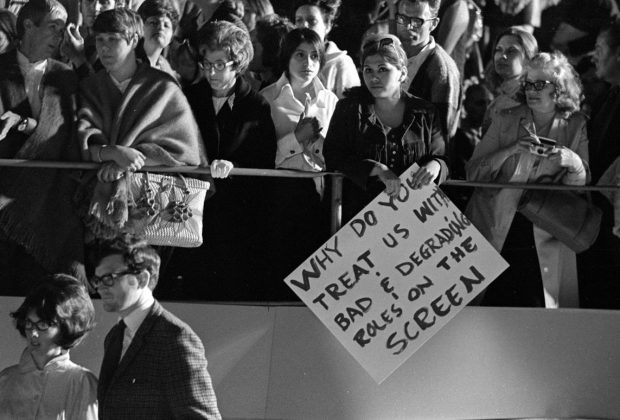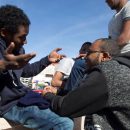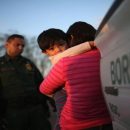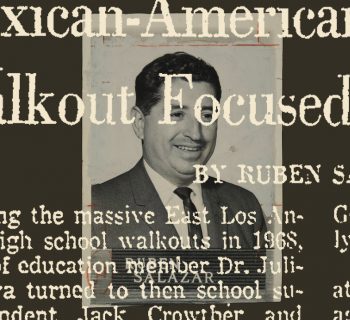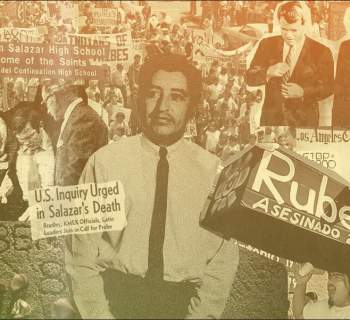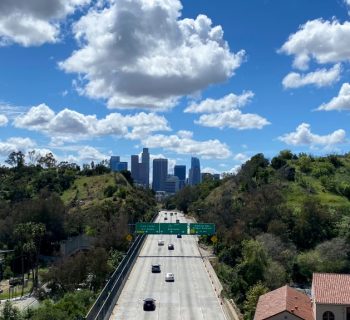By Jessica Wolf | UCLA Newsroom ~ December 28, 2017
There are photographs of crowds of people carrying protests signs, determined speakers holding megaphones, streams of people marching down streets of Los Angeles, facing down barricades. Images of bodies covered in bruises from police near portraits of children and families, moments captured of everyday life, of music and joy.
From 1967–1977 a publication called La Raza documented the struggle, the joys and the aspirations of Los Angeles’ Latino and Chicano communities. The mission of La Raza, which coincided with the rise of alternative media outlets across the country, was to tell the stories of the Chicano community in Los Angeles in ways that the major media outlets in the city were not.
Those efforts were fueled by the dedication of a dozen or so volunteer photographers — most of whom were of Chicano descent or were activist allies of a community fighting for visibility and equality.
“That’s why this collection of photographs is so important,” said Chon Noriega, director of the UCLA Chicano Studies Research Center. “It was a community photographing itself. It’s not just about the publication, but the larger universe of images that were generated and how a dozen-and-a-half people went out and tried to look at their world differently than the other two major sets of people photographing them, which were the traditional media and the L.A. County sheriff’s department.”
To make visible to the public what was once largely unseen, and remind a new generation of the efforts of a passionate community, the Chicano Studies Research Center partnered with the Autry Museum of the American West to create the “La Raza” exhibition, which is part of the Getty initiative Pacific Standard Time: LA/LA — a far-reaching and ambitious exploration of Latin American and Latino art in dialogue with Los Angeles.
The display at the Autry provides a poignant and thematic glimpse at what was taking place in Los Angeles during an era of demonstration, of pride and protest, the height of the civil rights movement in America. The people whose faces are made visible in the La Raza archive were fighting for hard things, and the photographers were fighting to change other people’s vision of that community’s fight, Noriega said.
“So much of what people were protesting at that time were the consequences of invisibility,” he said. “If you’re invisible you can be killed, you can be denied education you can be shipped off to war and then not recognized. I think it is something that all the major social movements of the 20th century really realized are core to the political issues.”
In 2013, the UCLA Chicano Studies Research Center became home to the 25,000 photographic images taken during La Raza’s decade-long existence, most of which have never been seen before. With the help of a grant from the Council of Information and Library Resources, the CSRC has spent three years digitizing and cataloging this collection for public access. The size of the collection rivals official photo documentation efforts like the U.S. Geologic Survey started in 1879.
The La Raza exhibition includes about 300 photos selected by curators Amy Scott from the Autry and Luis Garza, one of the photographers whose work is included in the show.
Long before almost every American could function as an amateur photojournalist and snap and share images from major events and everyday life via a handheld device, La Raza photographers were painstakingly documenting the struggles of their own community, developing film, turning their lenses back at the sheriff department officers and undercover agents that were prevalent at protests and gatherings.
It is a huge undertaking to ensure that these images are properly scanned, tagged with efficient and accurate metadata, that the file technology is constantly updated and upgraded. CRSC staff is working on interactive search technology that will broaden the possibilities of the archive as they eventually make it available to scholars and educators via a web platform.
“It’s important to be able to do dynamic archival research online,” Noriega said. “If you think of research in the terms of library book stacks, you are able to do two things — find the book you are looking for, but also, browse the stacks to find that book you didn’t know you were looking for. That browsing quality is what you really lose in a lot of digital archives, but we are trying to get at that with the interactive component to this collection.”
On site at the Autry visitors can interact with the entire collection via a large touchscreen. And CRSC is inviting input from visitors who might recognize a face or place from an image to add more of information and description to the database.
Scott, curator of the Autry exhibition, said it was a privilege to be the first to create an exhibition from the collection.
“The imagery really sits at the crossroads of a number of things, the arts, social history and Los Angeles, so it had a special appeal for us,” she said. “And it represented the perfect Pacific Standard Time project, which of course is all about art history and Latin America.”
There are lifetimes of exhibitions in the La Raza archive, Scott said. But several themes emerged as she looked through images, resulting in an organization of photographs arranged to reflect ongoing struggles, moments of solidarity and portraits from the Los Angeles’ community of civil rights activists, rather than tackling a series of chronological events. The exhibition also includes a series of harrowing images that tell the story of the death of L.A. Times reporter Ruben Salazar in 1970, which Noriega called a defining moment of the Chicano rights movement in L.A.
The installation, which will run until February 2019, is intended to be a teaching tool for Los Angeles educators. And collaborating with the Autry was ideal because the museum deftly straddles the worlds of art and cultural history, Noriega said.
“The exhibition is part of a larger vision of how to establish the collection of La Raza images that now reside at UCLA,” Noriega said. “It’s a starting point as we prepare the collection to be available worldwide.”
Source: By Jessica Wolf | UCLA Newsroom ~ December 22, 2017
For more information on exhibit or to see the video tour, click here.

